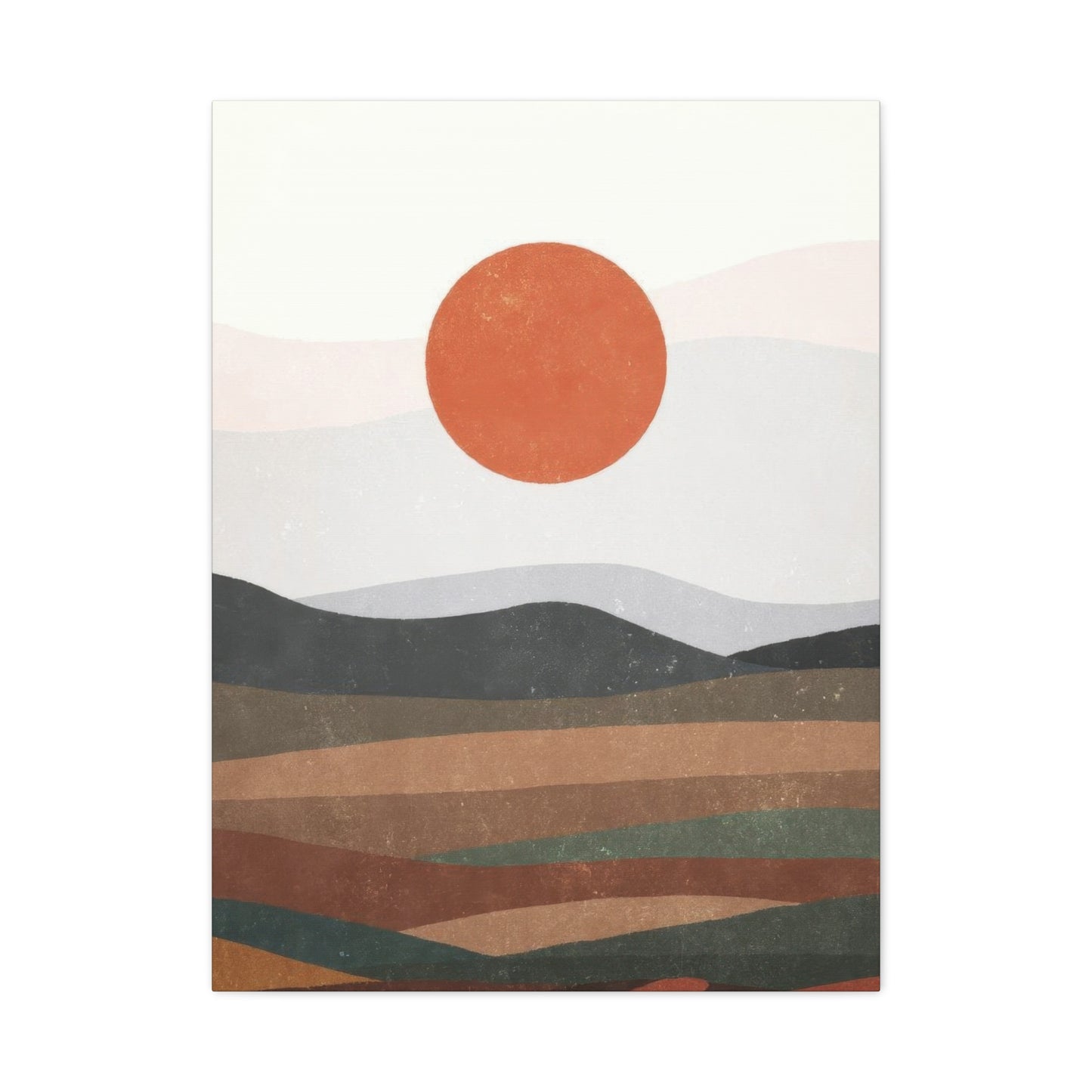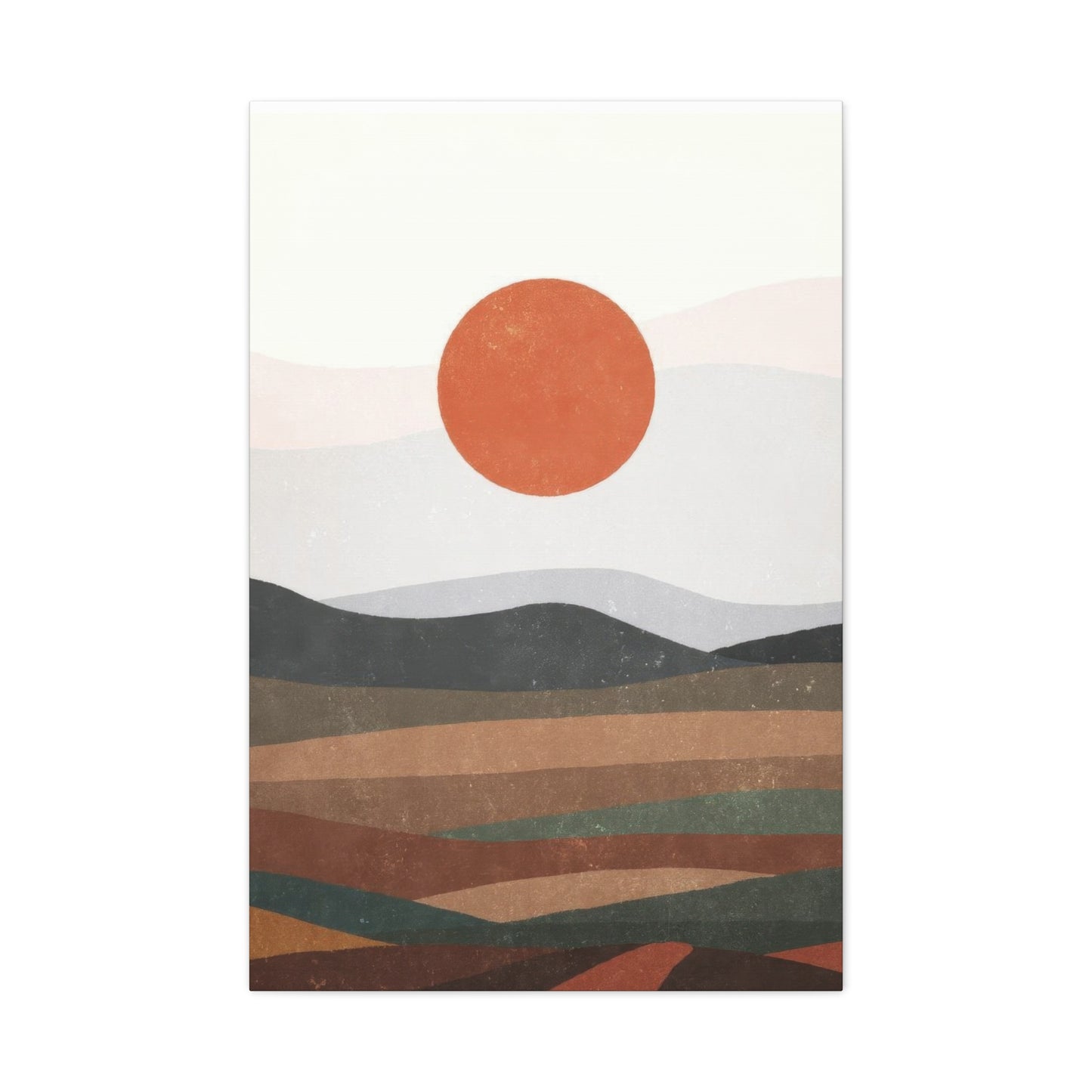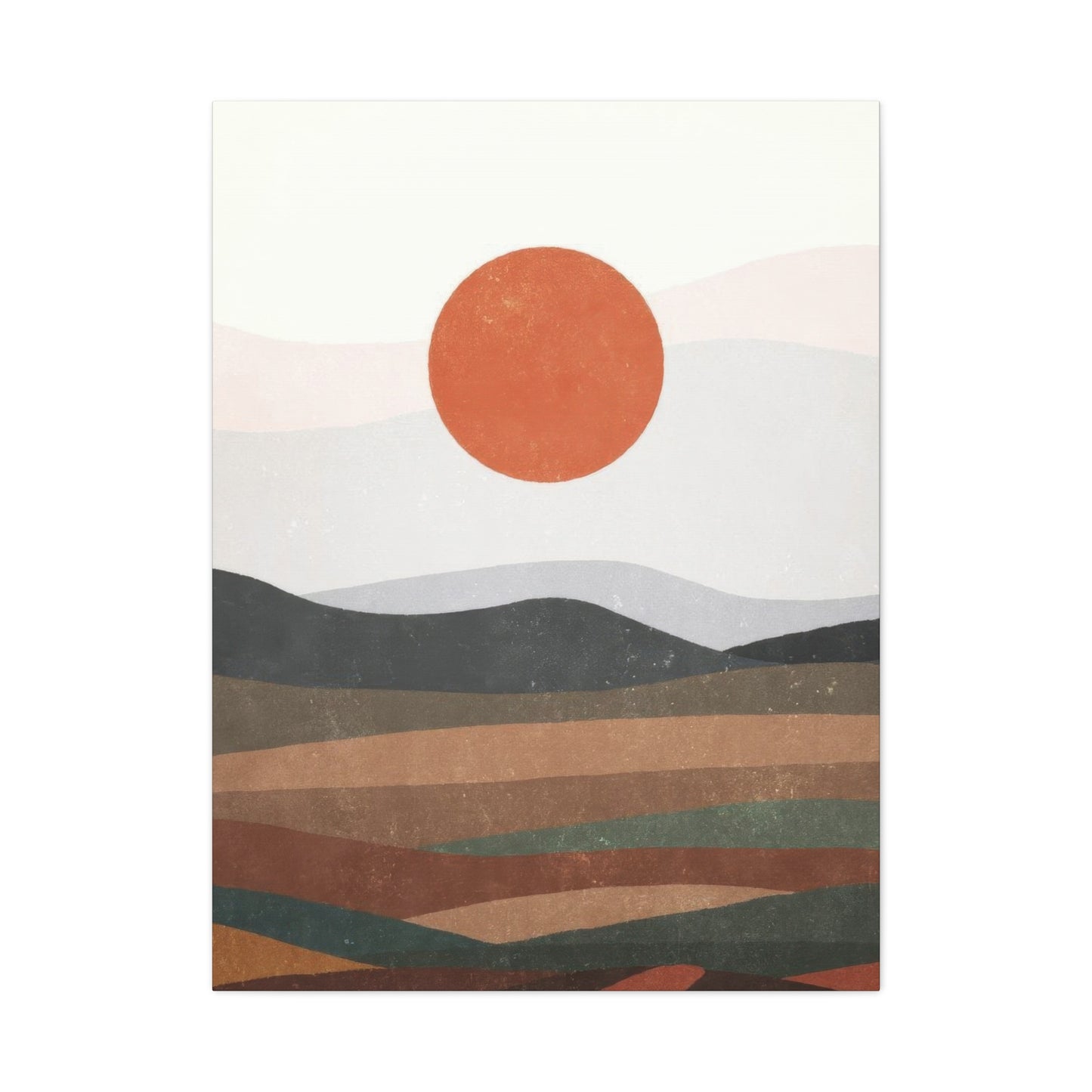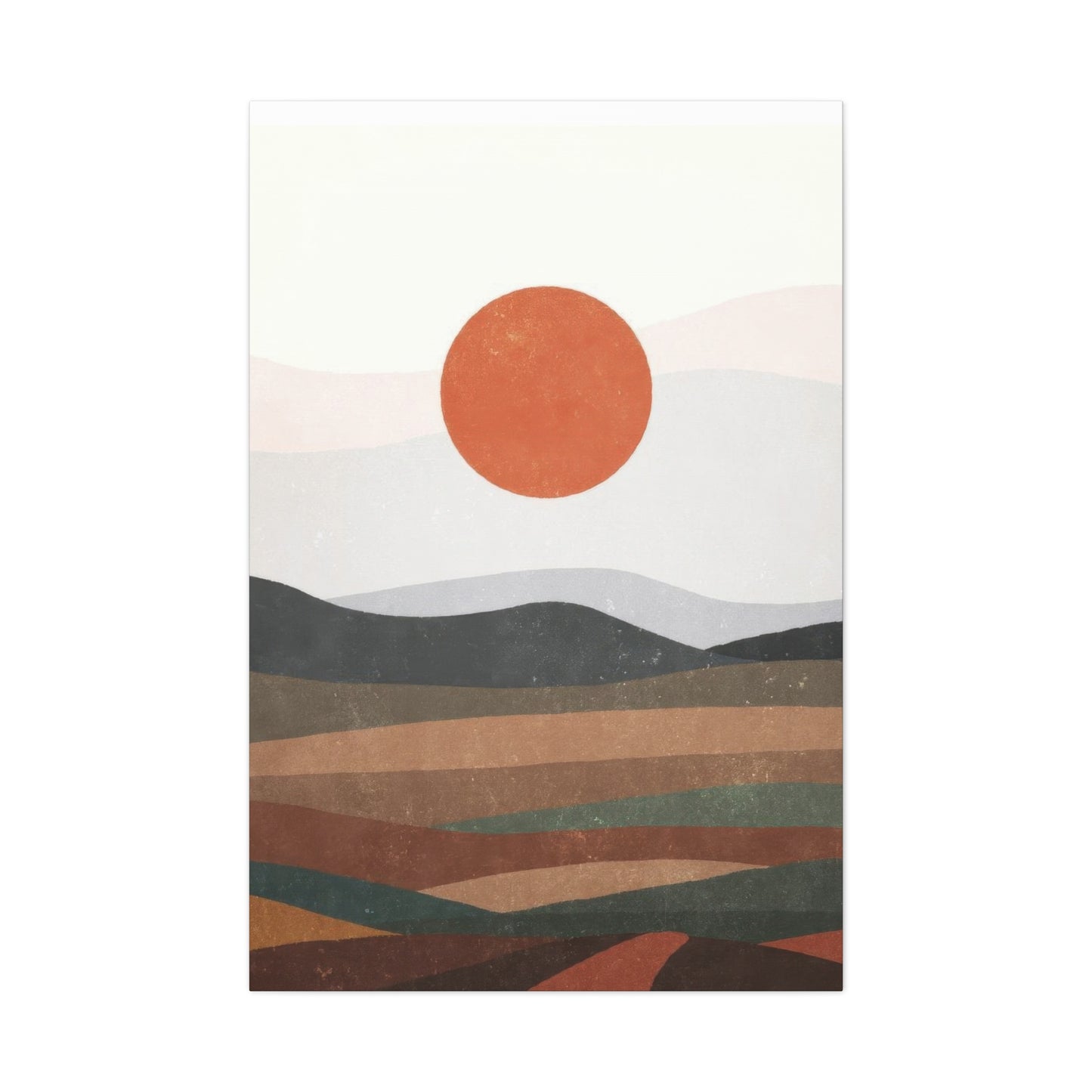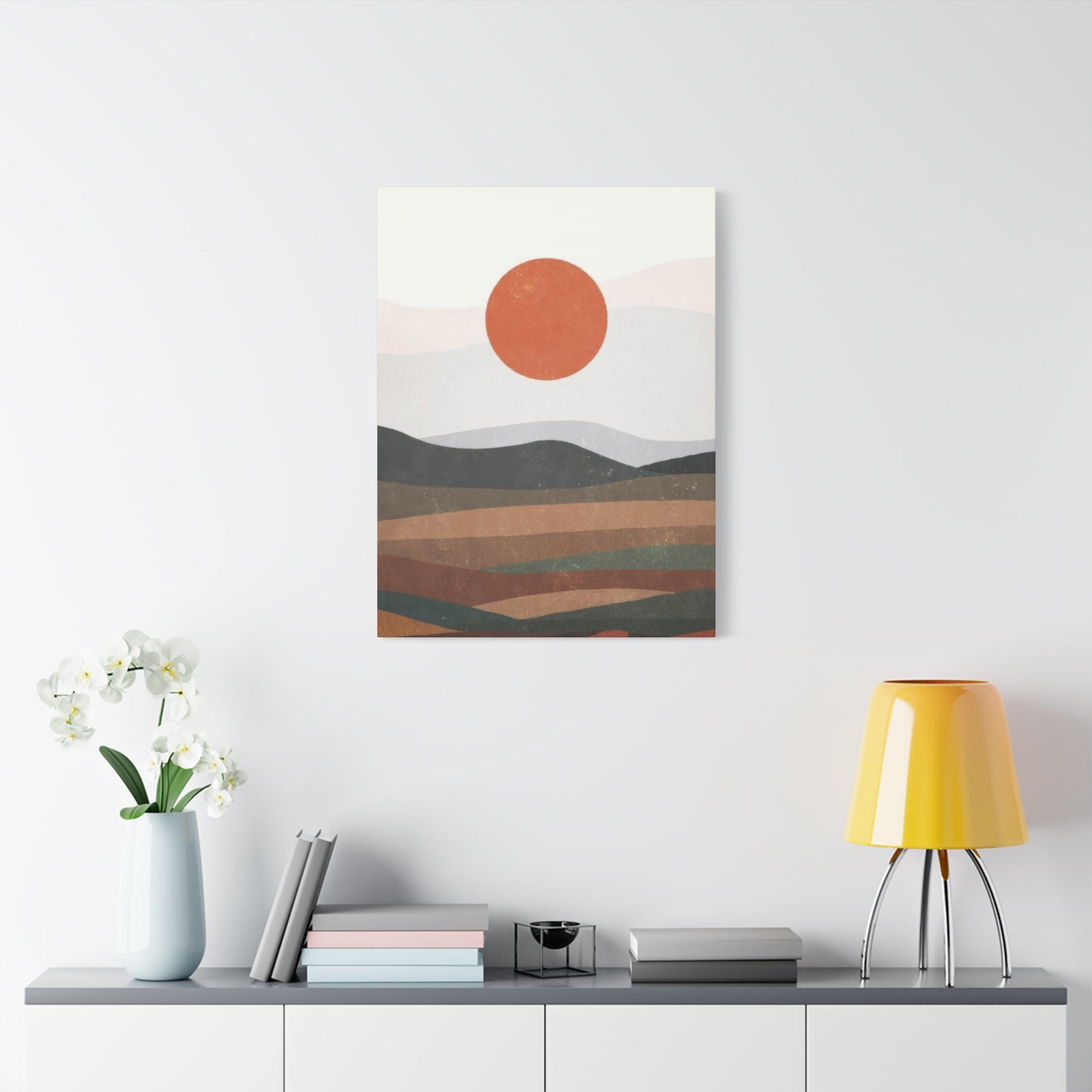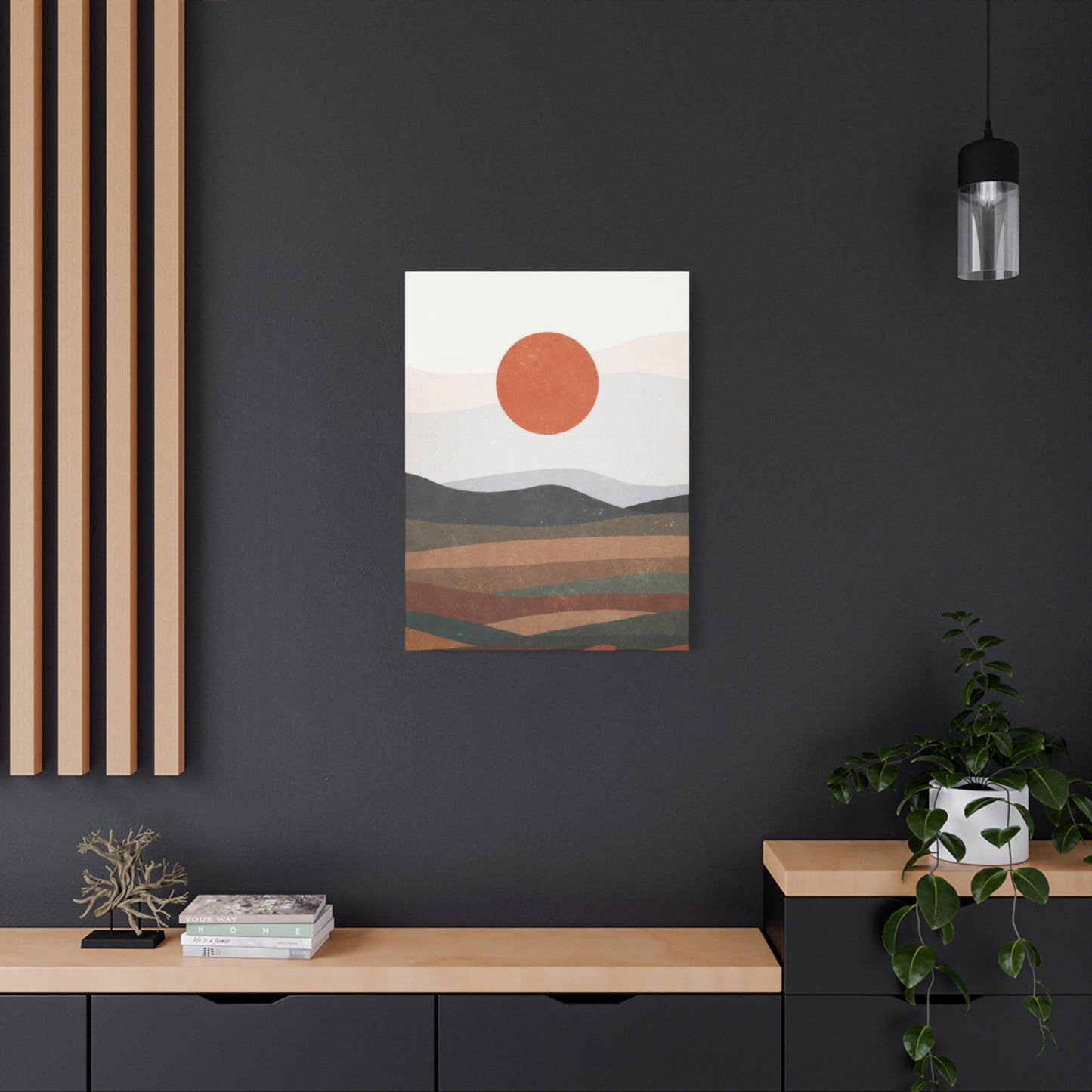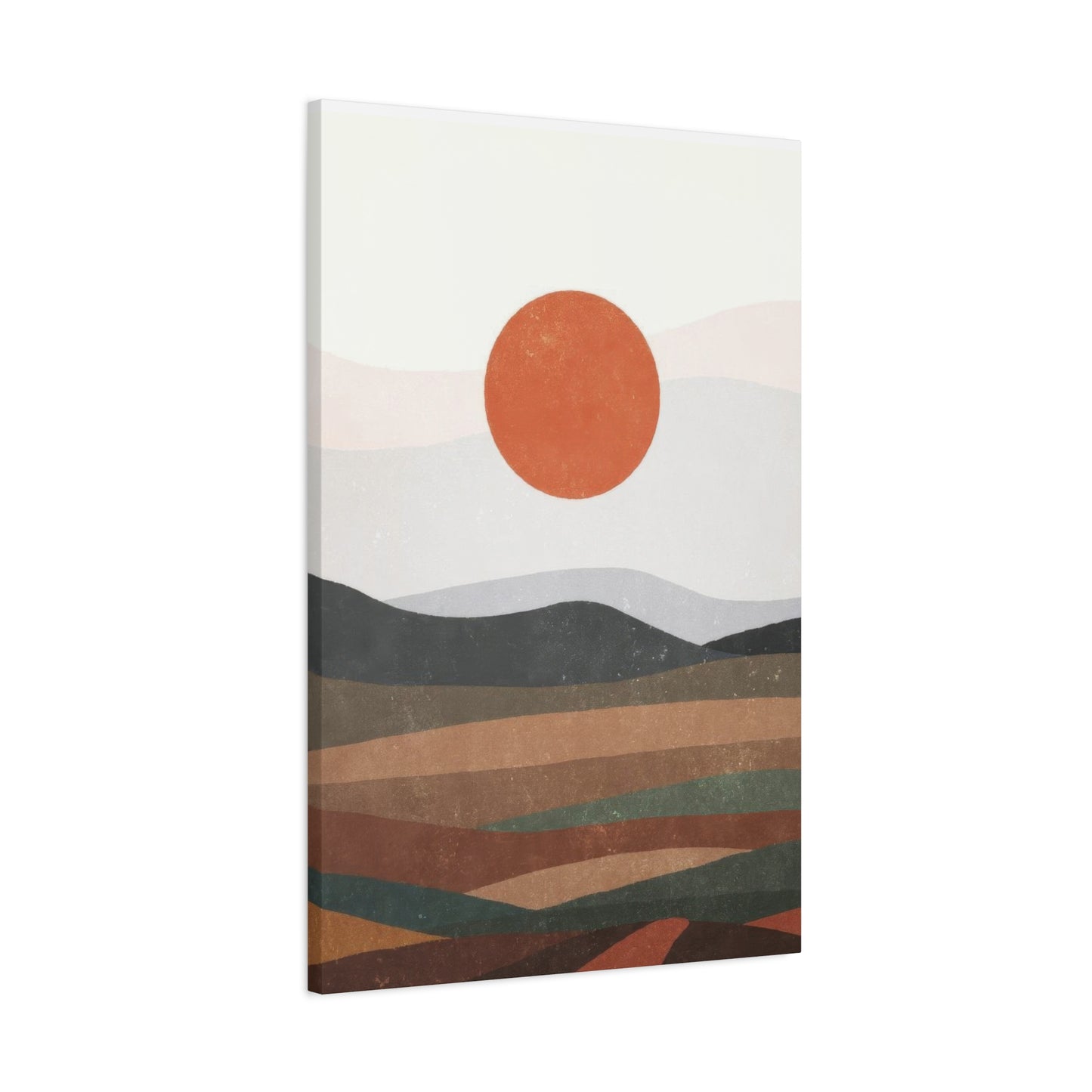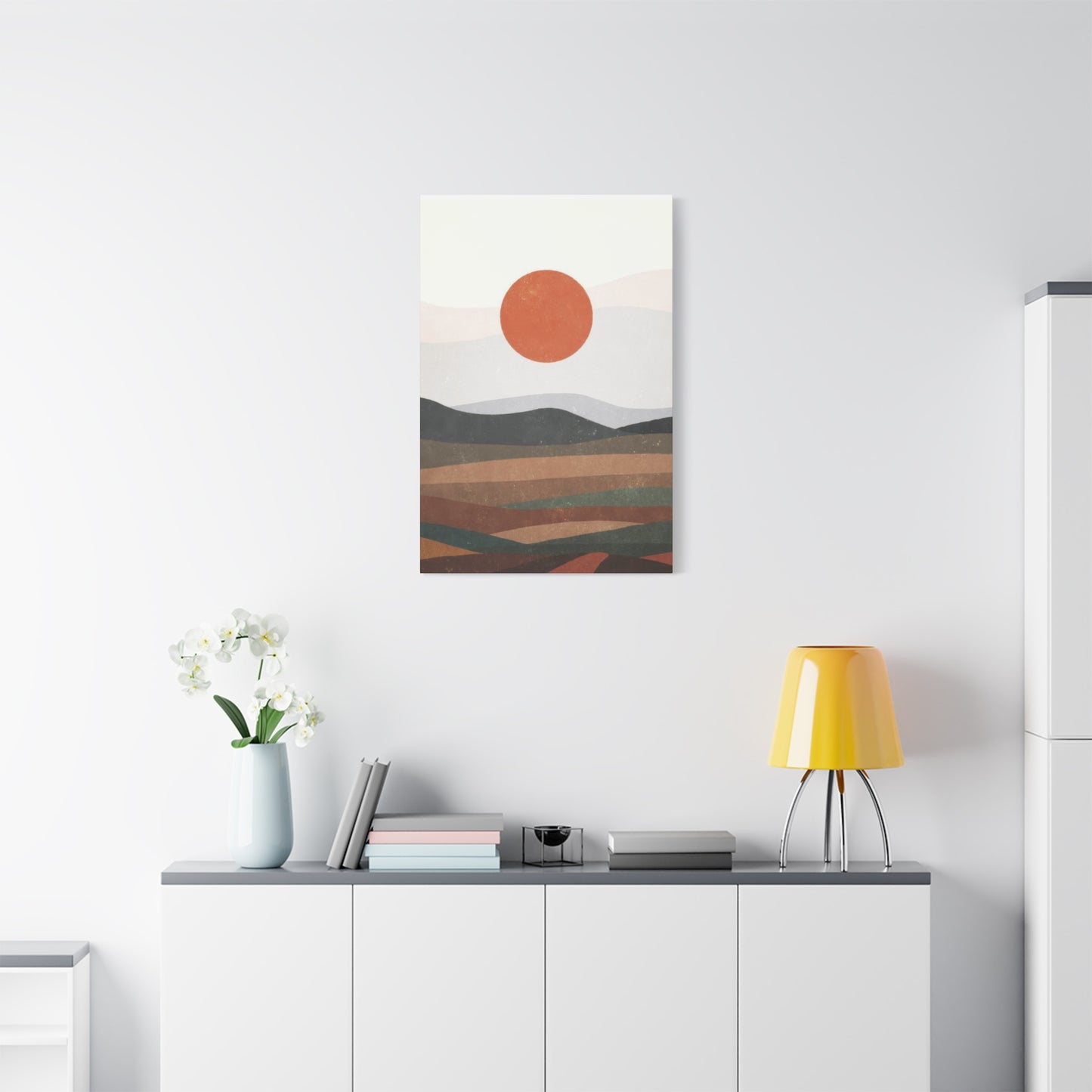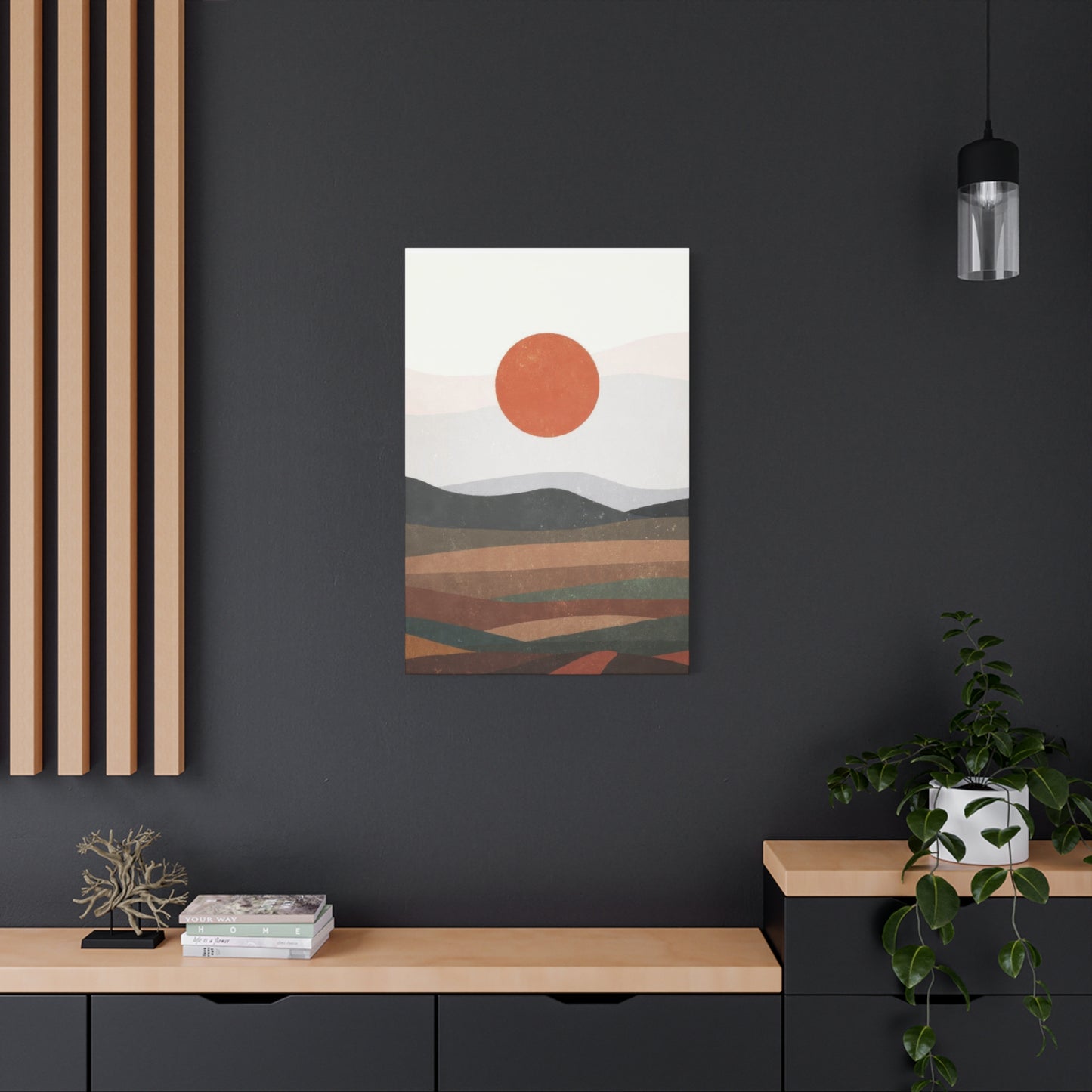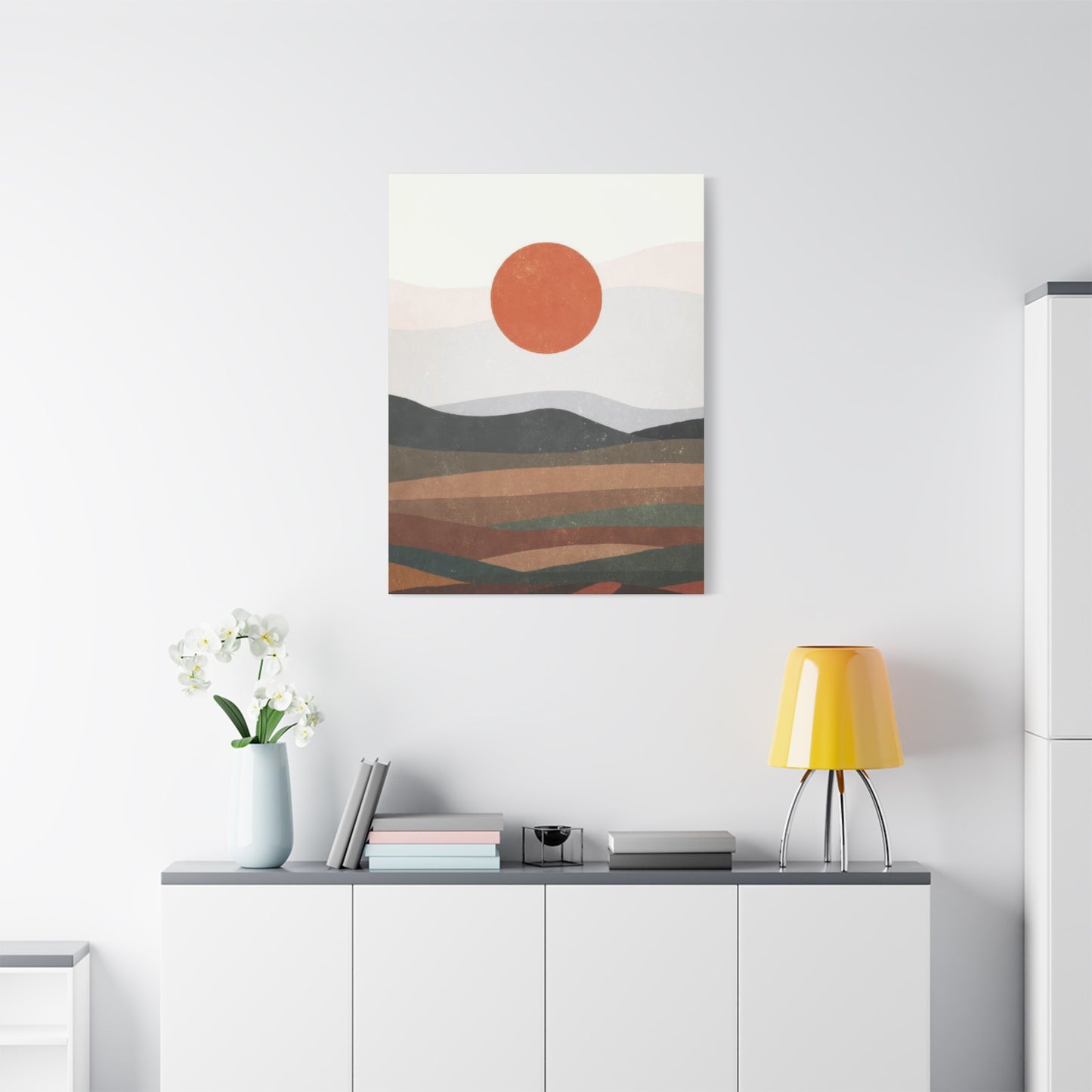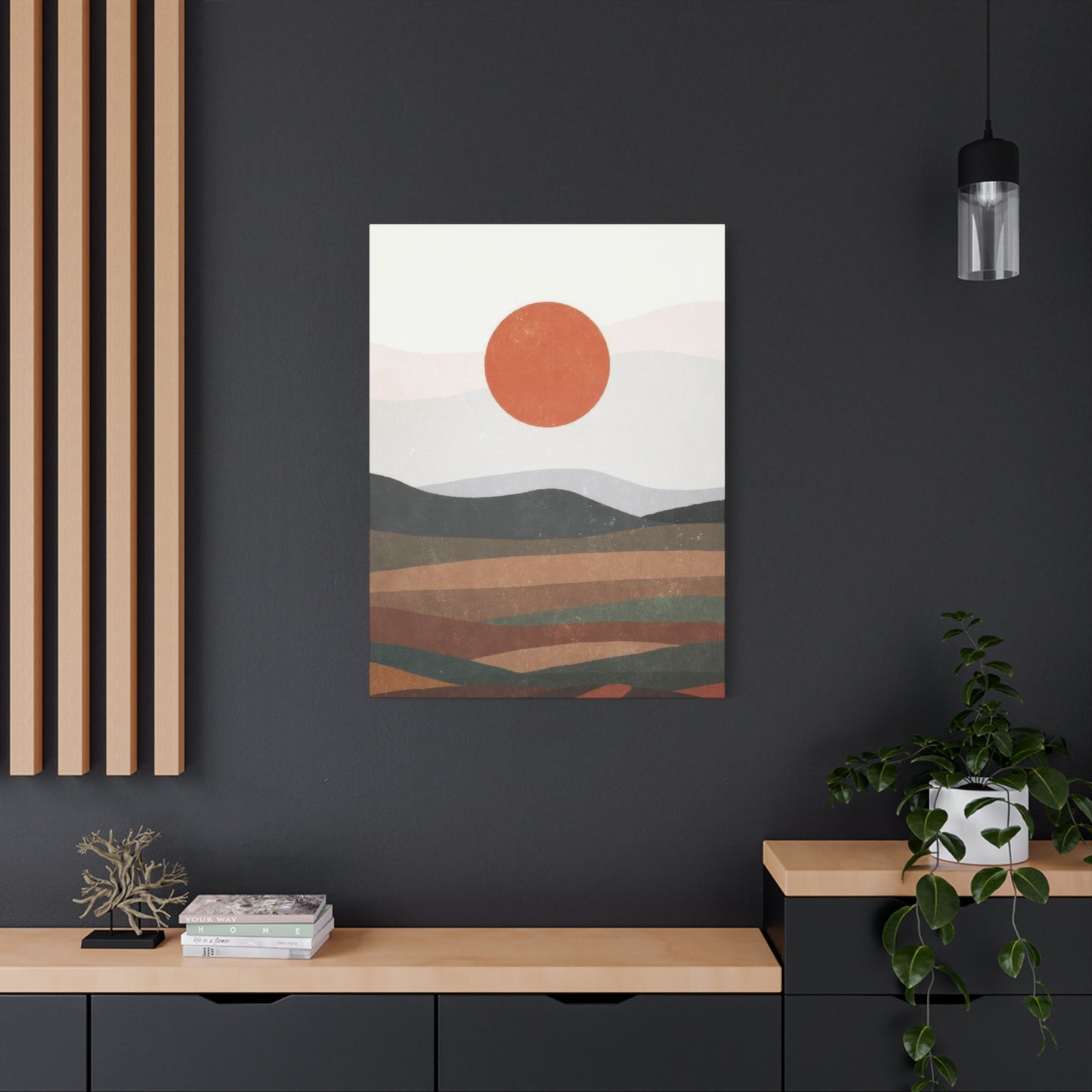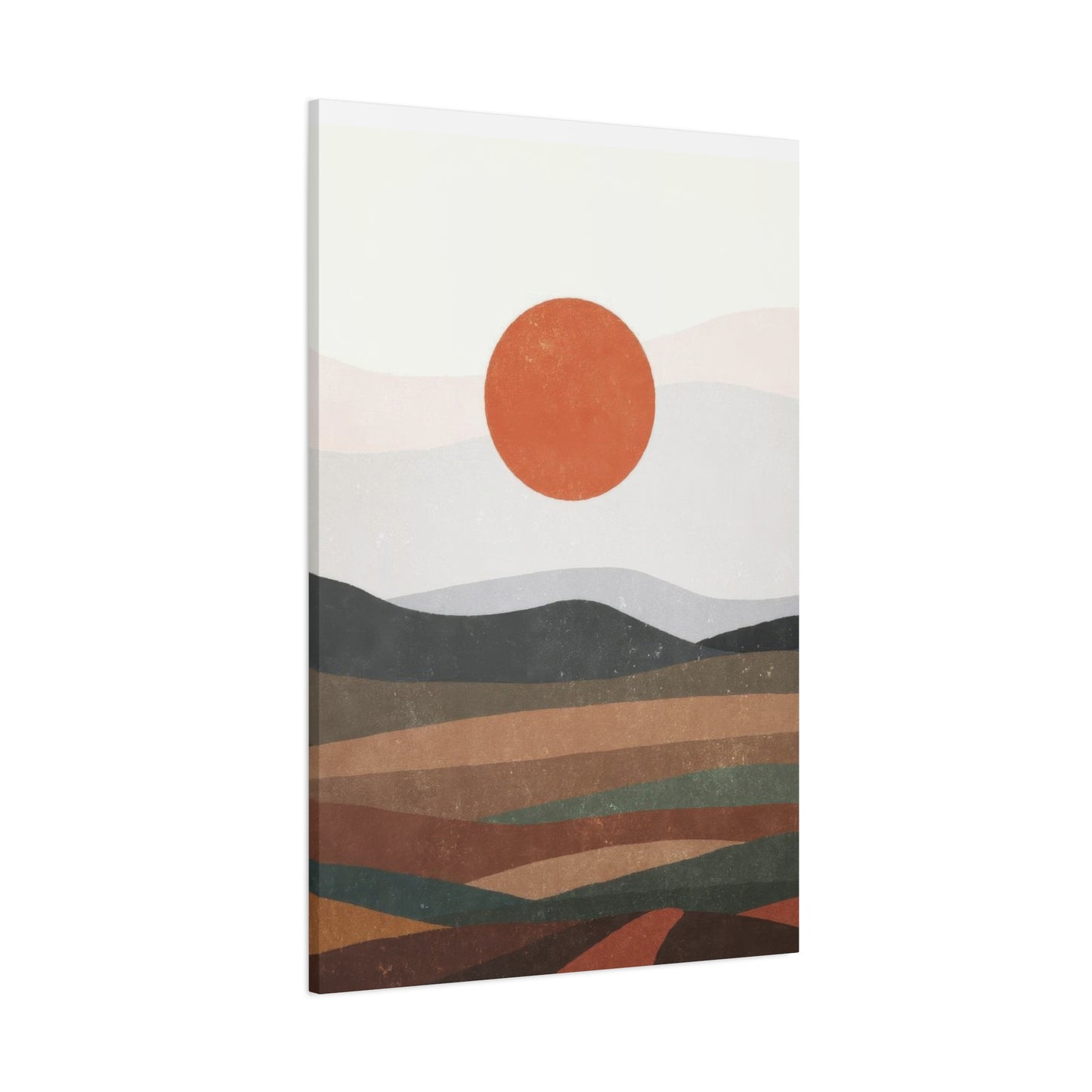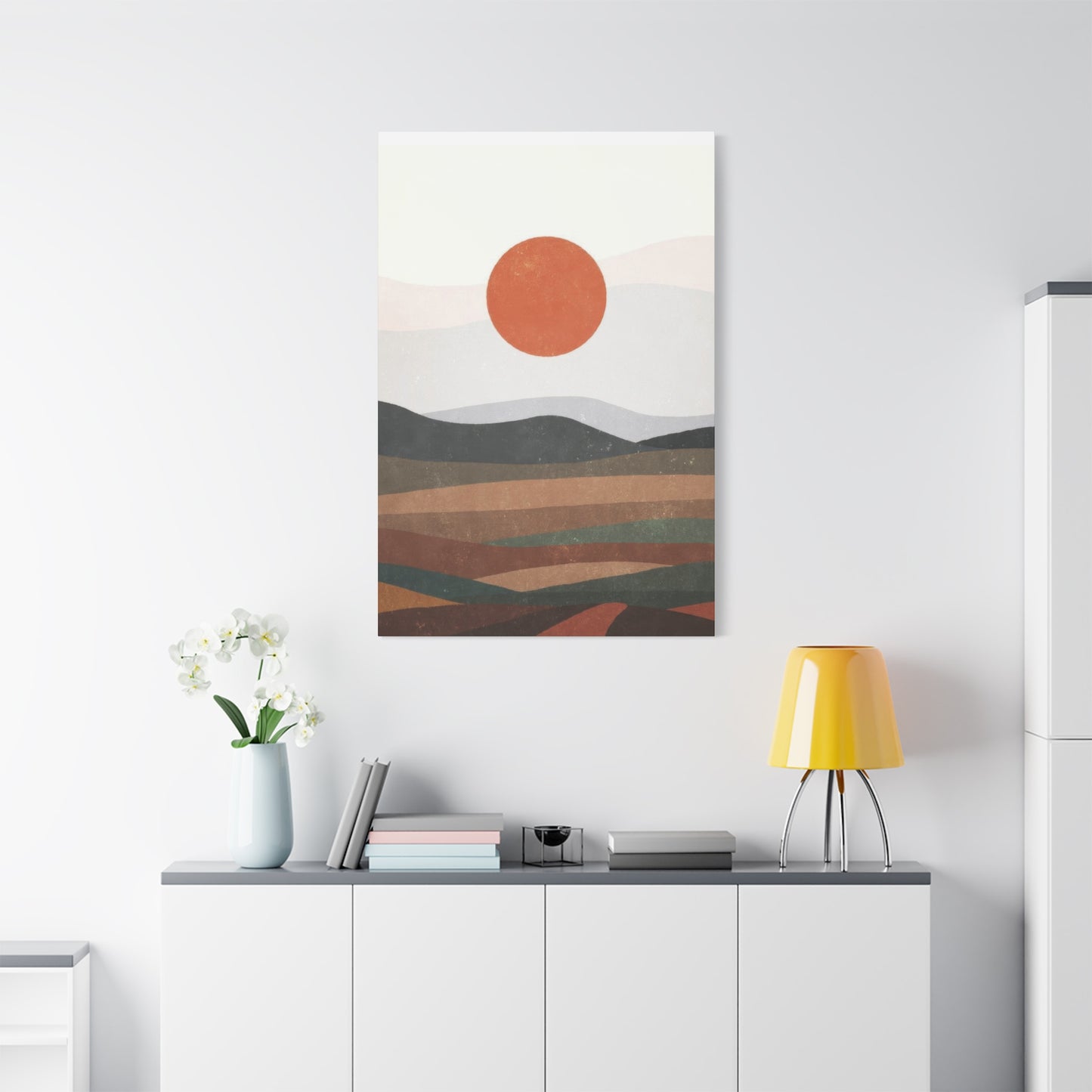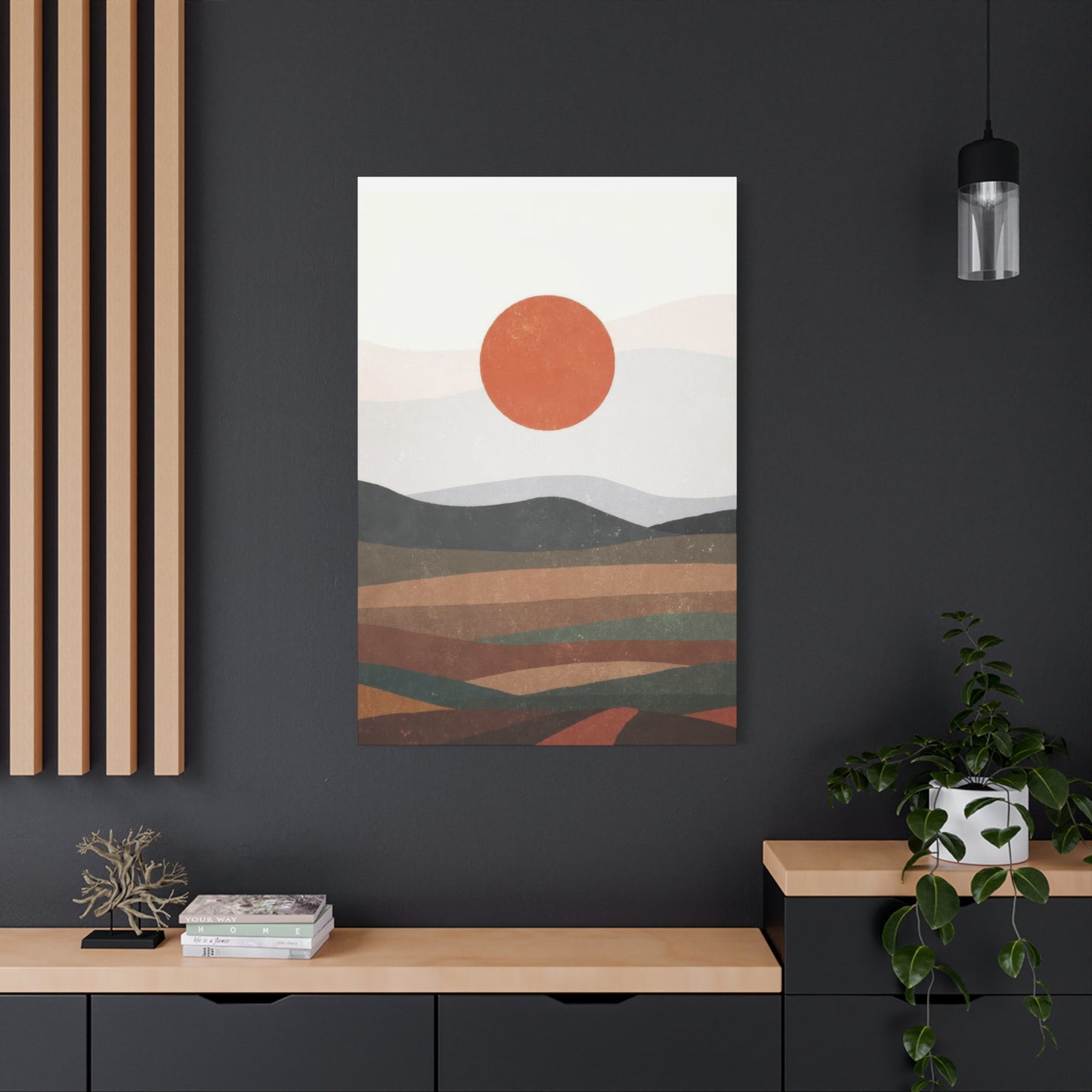Earth Tone Abstract Landscape Sunset Wall Art: Transforming Spaces with Natural Beauty
Creating a harmonious living environment goes beyond simply filling rooms with furniture and decorative items. The art pieces you choose to display on your walls possess an extraordinary ability to influence the entire atmosphere of your home, affecting everything from the mood of your space to the emotional responses of those who inhabit it. Among the countless artistic styles available to homeowners and interior design enthusiasts, earth tone abstract landscape sunset wall art has emerged as a particularly powerful choice for those seeking to establish environments that feel simultaneously sophisticated and comforting.
This comprehensive exploration delves into the multifaceted world of sunset-inspired abstract landscape artwork, examining how these pieces harness the natural beauty of fading daylight and ground their visual impact through the strategic use of earth-based color palettes. We will journey through various aspects of this artistic genre, from understanding the psychological effects of specific color combinations to discovering practical approaches for incorporating these works into diverse interior design schemes. Whether you are furnishing a new residence, refreshing an existing space, or searching for the perfect gift for someone who appreciates artistic expression, this guide will provide you with the knowledge and inspiration needed to make informed decisions about earth tone abstract landscape sunset art.
The marriage of abstract interpretation with landscape inspiration creates artwork that functions on multiple levels, offering both immediate visual appeal and deeper layers of meaning that reveal themselves over time. When these qualities are combined with the grounding influence of earth tones and the emotional resonance of sunset imagery, the result is artwork that possesses timeless appeal while remaining thoroughly contemporary in its execution.
Incorporating Natural Warmth Through Earth-Based Color Palettes in Interior Design
The decision to introduce earth-inspired hues into your living spaces represents far more than a superficial aesthetic choice. These colors, drawn from the natural world around us, carry inherent qualities that create immediate connections between our indoor environments and the landscapes that exist beyond our walls. When you select artwork featuring earth tones, you are essentially bringing fragments of the natural world into your home, establishing visual and psychological links to environments where humans have evolved to feel most comfortable and secure.
Earth tone palettes encompass a remarkably diverse range of colors, all united by their origin in natural materials and organic substances. The warm sienna tones reminiscent of sun-baked clay, the rich ochres that mirror autumn landscapes, the deep umbers found in fertile soil, the soft beiges that echo sand and stone, and the muted terracottas that recall ancient pottery traditions all fall within this category. These colors possess a unique characteristic that sets them apart from more vibrant or artificial hues they create warmth and welcome without overwhelming the senses, offering visual interest while maintaining a sense of calm restraint.
The psychological impact of earth tones has been studied extensively by researchers in environmental psychology and design theory. These investigations have consistently demonstrated that spaces decorated predominantly with earth-based colors tend to evoke feelings of stability, security, and groundedness in their occupants. Unlike cooler color schemes that might create feelings of distance or detachment, or overly bright palettes that can stimulate anxiety or restlessness, earth tones strike a balance that most people find inherently comfortable. This comfort stems partly from evolutionary factors, as these colors have surrounded humans throughout our species' development, appearing in the landscapes where we sought shelter, gathered food, and built our earliest communities.
When earth tones appear in abstract landscape sunset art, they serve multiple functions simultaneously. On the most basic level, they provide the foundational colors that anchor the composition, preventing more vibrant sunset hues from becoming visually overwhelming. The deep browns might represent distant landforms or shadowed valleys, while lighter beiges and tans suggest sunlit plains or desert expanses. These earthy elements create a sense of solidity and permanence within the artwork, grounding the more ephemeral qualities of sunset light in something tangible and enduring.
Beyond their compositional role, earth tones in sunset artwork create opportunities for sophisticated color harmonies that would be impossible with more limited palettes. The interaction between warm earth tones and the golden, amber, and rust colors typical of sunset light creates a cohesive visual experience where every element feels related and interconnected. This harmony extends beyond the artwork itself, making pieces that feature earth tone sunset palettes remarkably versatile when it comes to integration with existing interior design schemes.
Exploring the Aesthetic Appeal
The realm of abstract landscape representation offers artists and viewers alike a unique space where recognizable natural forms meet imaginative interpretation, creating artworks that reference the physical world while transcending literal representation. This approach to depicting sunset landscapes provides particular advantages, allowing artists to capture not just the visual appearance of fading daylight but the emotional and sensory experience of witnessing these daily transformations.
Traditional representational landscape art certainly possesses its own merits, offering detailed depictions that can transport viewers to specific locations and moments in time. However, abstract interpretation operates according to different principles, prioritizing emotional resonance and visual impact over documentary accuracy. When an artist approaches sunset landscape imagery through an abstract lens, they gain freedom to emphasize certain elements while simplifying or eliminating others, to exaggerate colors beyond their natural intensity, and to arrange compositional elements according to aesthetic considerations rather than geographic reality.
This interpretive freedom results in artwork that speaks to universal experiences rather than specific locations. While a photorealistic painting of a particular beach at sunset might appeal strongly to those familiar with that location while leaving others less engaged, an abstract interpretation of sunset over coastal landscapes can resonate with anyone who has ever experienced the emotional impact of watching day transform into evening. The abstraction removes geographical specificity, creating space for personal interpretation and allowing each viewer to project their own memories and associations onto the work.
The visual language of abstraction in landscape sunset art typically involves several key approaches. Some artists work through simplification, reducing complex natural scenes to their essential forms and colors. A sunset might be represented by broad horizontal bands of color that suggest horizon, sky, and land without depicting any of these elements in detail. Others approach abstraction through fragmentation, breaking apart recognizable landscape elements and rearranging them in ways that create new relationships and visual rhythms. Still others blend recognizable and abstract elements, perhaps rendering the sun and horizon with some degree of realism while treating foreground and background elements more interpretively.
Color takes on heightened importance in abstract landscape work, often becoming the primary vehicle for conveying mood and meaning. Freed from the obligation to match colors exactly to their natural counterparts, abstract artists can intensify hues, create unexpected color combinations, and use color relationships to guide the viewer's emotional response. A sunset might be rendered in colors more vivid than any real sunset, yet if the relationships between these colors echo natural patterns, the work still reads as connected to actual landscape experience. This selective intensification allows abstract sunset landscapes to capture the feeling of particularly memorable sunsets, those moments when natural beauty reaches such intensity that it almost seems unreal.
Integrating Abstract Landscape Sunset Artwork
Contemporary modern interior design, with its emphasis on clean lines, uncluttered spaces, and thoughtful material choices, might initially seem at odds with the organic warmth of abstract landscape sunset art. However, this apparent tension actually creates opportunities for particularly effective and memorable design solutions. When earth tone sunset landscapes are skillfully integrated into modern interiors, they provide exactly the elements of warmth, texture, and natural connection that prevent contemporary spaces from feeling cold or impersonal.
Modern design principles prioritize simplicity and intentionality, with each element serving clear purposes rather than existing merely for decorative excess. This approach aligns perfectly with carefully selected statement artwork, as a single powerful piece can provide all the visual interest and personality a modern room requires. An expansive abstract landscape featuring sunset colors and earth tones becomes not just decoration but a fundamental component of the interior architecture, as essential to the space as furniture placement or lighting design.
The color palettes typical of modern interiors often lean toward neutrals, whites, grays, and blacks, creating sophisticated but potentially austere environments. Earth tone sunset artwork introduces warmth into these cool neutral schemes without disrupting their fundamental character. The earthy browns, tans, and beiges in the artwork share the neutral quality of modern color schemes while bringing warmth that prevents spaces from feeling sterile. Meanwhile, the sunset colors provide accent notes that animate the space, serving functions similar to accent pillows or decorative objects but with greater visual impact and artistic credibility.
Scale considerations become particularly important when integrating artwork into modern interiors, where generous proportions and bold statements typically work better than collections of smaller pieces. Contemporary design tends to favor fewer, larger elements over cluttered arrangements, a principle that applies equally to artwork selection. A substantial abstract landscape sunset piece, perhaps spanning most of a wall's width, creates the kind of commanding presence that complements modern architectural features. The horizontal orientation common in landscape formats works especially well in modern spaces, echoing the horizontal emphasis often found in contemporary furniture design and architectural detailing.
Material considerations extend beyond the artwork itself to encompass framing and presentation choices. Modern interiors typically feature sleek, minimalist framing if any framing at all. Many contemporary spaces showcase artwork without frames, allowing pieces to float against walls or mounting them with minimal hardware. When frames are used, they tend toward simple profiles in materials like natural wood, metal, or acrylic rather than ornate traditional frames. For earth tone sunset landscapes, simple wooden frames in natural finishes can be ideal, creating subtle borders that complement the organic nature of the subject matter while maintaining modern simplicity.
Earth-Based Color Palettes in Abstract Landscape Wall Artwork
Earth-based color palettes possess an inherent power that transcends mere aesthetic appeal, tapping into deep human connections with the natural world while offering practical advantages in interior design applications. When these palettes appear in abstract landscape wall art, particularly pieces inspired by sunset imagery, their transformative potential reaches full expression, creating artworks that function simultaneously as beautiful objects, emotional touchstones, and unifying design elements.
The psychology underlying human responses to earth tones reflects millions of years of evolutionary development. Our ancestors lived entirely within natural environments, surrounded constantly by the browns of soil and bark, the beiges of dried grasses and sand, the tans of stone and clay. These colors signaled safety, resources, and the fundamental substances necessary for survival and shelter. While modern humans live primarily in constructed environments, these deep-seated associations persist, creating unconscious positive responses to earth tone color schemes. Spaces decorated with these colors feel fundamentally safe and welcoming, triggering responses that operate below conscious awareness.
The specific colors within earth tone palettes each carry their own associations and effects. Deep, rich browns suggest stability and permanence, evoking the solid earth beneath our feet. These darker earth tones create visual weight and grounding in compositions, anchoring lighter elements and providing foundational structure. Medium browns with warmer undertones bring to mind aged wood, worn leather, and autumn leaves, creating associations with comfort, tradition, and natural aging processes. These colors carry inherent warmth without the intensity of bright warm hues, offering welcoming qualities that remain comfortable for extended viewing.
Lighter earth tones including beiges, tans, and soft terracottas function differently in compositions and spatial contexts. These colors possess warmth while maintaining high reflectivity, contributing to bright, open-feeling spaces without the starkness of pure white. In abstract landscape artwork, these lighter earth tones often represent illuminated areas, suggesting sunlit plains, sandy beaches, or desert expanses. Their presence balances darker earth tones while maintaining overall palette cohesion.
The versatility of earth tone palettes becomes particularly apparent when considering their compatibility with diverse design styles and color schemes. These colors harmonize naturally with other natural materials and colors, creating effortless integration with wood furniture, stone surfaces, and plant life. They also work surprisingly well with more unexpected partners, softening the edge of industrial materials like metal and concrete while adding warmth to cooler color schemes dominated by blues, greens, or grays.
In abstract landscape contexts, earth tones serve multiple compositional functions beyond their color qualities. They can represent literal landscape elements like soil, rock, and vegetation, providing grounding visual references within otherwise abstract compositions. They can also function as neutral backgrounds against which more intense sunset colors perform, creating stages that allow dramatic hues to shine without competition. Additionally, earth tones can serve as transitional colors, bridging between different areas of compositions and helping to unify diverse elements into coherent wholes.
Discovering Why Abstract Landscape Sunset Art
The creation of genuinely cozy spaces involves far more than simply arranging comfortable furniture or adding soft textiles. True coziness emerges from the successful combination of multiple elements, including appropriate lighting, thoughtful color selection, pleasing textures, and the ineffable quality of spaces that feel personally meaningful and emotionally supportive. Abstract landscape sunset artwork featuring earth tones contributes to each of these dimensions, making such pieces ideal choices for spaces intended to serve as comfortable retreats from the demands of daily life.
The concept of coziness, particularly as understood through the Danish notion of hygge or similar cultural frameworks, emphasizes the creation of intimate, warm, welcoming environments that encourage relaxation, social connection, and contentment. These spaces typically feature soft lighting rather than harsh illumination, warm color palettes rather than cool ones, natural materials rather than synthetic, and personal touches that reflect inhabitant identity. Abstract sunset landscapes naturally align with these principles, bringing warmth through their color palettes, natural references through their subject matter, and opportunities for personal connection through their interpretive nature.
Lighting considerations prove particularly important in cozy space creation, and artwork featuring sunset imagery contributes to successful lighting environments in multiple ways. The warm colors typical of sunset palettes interact with both natural and artificial light to enhance warm illumination while absorbing cooler light frequencies. When properly lit, these artworks appear to generate their own glow, creating focal points that draw attention while radiating warmth throughout the space. This effect proves especially valuable during evening hours, when the artwork's sunset colors echo the quality of comfortable artificial lighting, reinforcing the warm, enclosed feeling that characterizes cozy environments.
The psychological comfort provided by landscape imagery, even in abstract form, connects to biophilic design principles, which recognize humans' innate need for connection with natural systems and processes. Cozy spaces succeed partly through their ability to create feelings of shelter and protection, separating inhabitants from external stresses while maintaining subtle connections to the broader natural world. Landscape sunset art facilitates these connections without requiring actual views or direct nature access, bringing the restorative qualities of natural imagery into enclosed urban spaces or rooms without exterior walls.
Scale and proportion considerations affect how artwork contributes to coziness, with different approaches appropriate depending on room dimensions and purposes. In smaller, more intimate spaces, moderately sized sunset landscape pieces create focal points without overwhelming limited wall areas. These pieces draw attention and provide visual interest while maintaining the enclosed, protected feeling that characterizes cozy small spaces. In larger rooms where coziness might be harder to achieve, oversized artwork can help define intimate zones within the broader space, creating visual anchors around which furniture groupings and activity areas organize themselves.
The softening effect that earth tone sunset artwork provides becomes particularly valuable in cozy space creation. Contemporary interiors often feature hard surfaces like wood floors, tile, glass, and metal, materials chosen for their durability and ease of maintenance but potentially contributing to harsh, echoey, inhospitable environments. While textiles like rugs, curtains, and upholstery add softness, artwork contributes visual softening, its organic colors and forms counterbalancing geometric precision and industrial materials. This visual softening proves especially important in loft-style spaces or studio apartments where architectural features might trend toward industrial rather than traditionally residential character.
Personal connection and meaning constitute essential components of truly cozy spaces, distinguishing these environments from impersonal hotel rooms or staged design showcase spaces. Abstract landscape sunset art facilitates personal connection through its interpretive nature, allowing viewers to project their own experiences, memories, and associations onto the work. Someone who has spent memorable time in desert landscapes might connect deeply with abstract sunset art featuring sandy earth tones, while another person might respond more to pieces suggesting forested hillsides at dusk. This personal resonance makes the artwork feel specifically chosen rather than generically decorative, contributing to the sense that the space reflects its inhabitant's identity.
Exploring How Abstract Sunset Landscape Imagery
The human relationship with sunsets extends far beyond simple visual appreciation, touching something fundamental in our psychological and emotional makeup. Sunsets mark daily transitions, signal rest periods approaching, and provide spectacular natural displays that temporarily interrupt routine concerns. Abstract landscape sunset art captures and extends these qualities, creating permanent representations of transient moments that consistently evoke calm, peace, and contemplative states in viewers.
The physiological dimension of sunset responses begins with the colors themselves, particularly the warm oranges, golds, and reds that dominate sunset palettes. Research in color psychology has demonstrated that exposure to these warm hues triggers measurable changes in physical states, including reduced heart rate, lowered blood pressure, and decreased muscle tension. These responses occur partly through learned associations, as we've experienced countless sunsets during relaxing evening hours, but they also reflect direct biological responses to specific wavelengths of light. When these colors appear in artwork, they trigger similar responses, creating measurable relaxation effects even in viewers who are not consciously aware of the art's influence.
The temporal associations embedded in sunset imagery contribute significantly to their calming effects. Sunsets mark the transition from active daytime to restful evening, signaling that the workday has ended and leisure time approaches. Even for people whose schedules don't follow traditional daylight patterns, these associations persist as cultural and biological inheritances. Abstract sunset landscape art thus carries connotations of release, permission to rest, and freedom from productivity demands. Viewing such artwork can trigger anticipatory relaxation responses, preparing mind and body for downtime even when actual sunset remains hours away.
The meditative quality of watching actual sunsets translates effectively into abstract artistic representations. Observing a sunset typically involves sustained, focused attention, watching as colors shift and intensify before fading. This concentrated observation creates meditative states, temporarily quieting mental chatter and anchoring awareness in present-moment sensory experience. Abstract sunset artwork invites similar focused attention, with viewers naturally drawn to trace color transitions, explore compositional relationships, and absorb the piece's overall emotional tone. This engagement provides brief respites from scattered, multitasking mental states, offering opportunities for cognitive rest and emotional centering.
Symbolism Embedded in Sunset Imagery
Sunsets have functioned as powerful symbols throughout human history, appearing in art, literature, mythology, and spiritual traditions across virtually all cultures. When contemporary artists incorporate sunset imagery into abstract landscape work, they tap into this rich symbolic heritage while creating pieces that speak to current sensibilities. Understanding the multiple layers of meaning embedded in sunset symbolism enhances appreciation for abstract landscape art and illuminates why these pieces resonate so powerfully with diverse audiences.
The most fundamental symbolic dimension of sunsets involves endings, transitions, and the cyclical nature of existence. Each sunset marks a day's conclusion, a small ending that occurs within the larger pattern of continuous cycles. This symbolism carries both melancholic and hopeful dimensions. The melancholy stems from sunset's association with closure, the end of opportunities, and the approach of darkness. However, the hopeful aspect emerges from certainty of return, the knowledge that this ending is temporary and another beginning awaits. Abstract sunset landscape art captures this dual nature, creating pieces that acknowledge impermanence while celebrating the beauty found in transitional moments.
Transformation represents another core symbolic theme associated with sunset imagery. The dramatic color changes that occur as sun approaches the horizon demonstrate natural transformation, showing how single elements can manifest in radically different forms while maintaining essential identity. The same sun that appeared white or yellow at midday becomes orange, red, even purple at day's end, illustrating that transformation need not mean loss of self but can instead represent different expressions of unchanging essence. This symbolism carries particular resonance in contemporary contexts, where personal transformation, growth, and continuous adaptation have become cultural imperatives.
The balance between light and darkness that sunsets embody provides rich symbolic territory for artistic exploration. Sunsets exist in the liminal space between day and night, occupying the threshold where neither full light nor complete darkness dominates. This balanced state symbolizes numerous philosophical and psychological concepts, including the integration of opposites, the coexistence of contrasting qualities, and the possibility of holding apparently contradictory truths simultaneously. Abstract sunset landscape art can emphasize this balance through compositional choices, color relationships, and tonal ranges that honor both illumination and shadow without allowing either to completely dominate.
Beauty in impermanence constitutes yet another symbolic layer present in sunset imagery. Sunsets represent quintessentially temporary phenomena, never appearing exactly the same way twice and existing only briefly before fading. Despite or perhaps because of this transience, sunsets rank among nature's most celebrated displays, attracting devoted observers who gather specifically to witness these fleeting moments. This celebration of ephemeral beauty challenges cultural emphasis on permanence and preservation, suggesting that temporary experiences can possess profound value. Abstract landscape art referencing sunsets carries this message, creating permanent objects that commemorate impermanent natural events and invite reflection on the relationship between transience and lasting meaning.
Examining Abstract Landscape Sunset Art
The creation of successful abstract landscape sunset art requires sophisticated understanding of both natural phenomena and color theory principles, bringing together observational awareness and formal artistic knowledge. Artists working in this genre must translate their understanding of how light, atmosphere, and landforms interact during sunset hours into abstract visual languages that capture essential qualities without relying on realistic representation. The resulting fusion produces artwork that honors natural inspiration while celebrating the unique possibilities of abstraction.
Color theory provides the foundational framework through which artists organize and deploy their palettes. Understanding relationships between hues, including complementary pairings, analogous harmonies, and color temperature contrasts, allows artists to create compositions that feel balanced and resolved even when featuring bold, intense colors. Sunset palettes naturally emphasize warm hues ranging from yellows through oranges to reds and purples, colors that sit adjacently on the color wheel and thus create harmonious relationships. When earth tones enter these palettes, they provide grounding neutral and near-neutral elements that prevent warmth from becoming overwhelming while maintaining overall color unity.
The atmospheric effects that make natural sunsets so visually dramatic provide inspiration for abstract interpretation while posing challenges for artistic translation. During sunset, light travels through greater expanses of atmosphere than during midday, scattering shorter wavelengths and allowing longer wavelengths to dominate, creating the characteristic warm colors. Additionally, particles in the atmosphere scatter and diffuse light, creating gradations, halos, and bands of color. Abstract artists must find ways to suggest these effects without realistic rendering, perhaps through careful gradients, strategic color placement, or textural variations that imply atmospheric depth and complexity.
Spatial construction in abstract landscape work draws on understanding of how actual landscapes organize themselves while embracing freedom to rearrange and reimagine these relationships. Natural landscapes typically feature horizontal organization, with ground, horizon, and sky creating broad bands at different elevations. Many abstract sunset landscapes maintain this horizontal emphasis while abstracting the specific details of each zone. Artists might suggest ground through darker earth tones in lower compositional areas, imply sky through lighter, warmer colors above, and indicate horizon through transitional zones where these regions meet. However, abstraction allows for departures from this formula, with artists free to fragment, rotate, or completely reimagine spatial relationships according to aesthetic priorities.
Texture plays particularly important roles in abstract work, becoming a primary means of creating visual interest and suggesting form without realistic detail. Artists working with paint might build thick impasto surfaces that catch light and create actual three-dimensional relief, adding sculptural dimensions to fundamentally two-dimensional artworks. Alternatively, they might work with thin glazes that create luminous, atmospheric effects reminiscent of sunset light filtering through haze. Mixed media approaches incorporating materials beyond traditional paint expand textural possibilities further, allowing integration of sand, fabric, paper, or other materials that bring associations and physical properties relevant to landscape themes.
Practical Strategies for Styling Your Living Spaces
Successfully incorporating abstract landscape sunset art into your home requires more than simply hanging a piece on an available wall. Thoughtful consideration of placement, surrounding elements, lighting, and overall design strategy ensures that the artwork achieves its full potential, functioning as an integral component of your interior environment rather than an afterthought addition. These practical strategies will help you make the most of earth tone sunset landscape pieces in any room.
Initial assessment of your existing color scheme provides essential foundation for artwork selection and placement decisions. Walk through your space and identify the dominant colors present in large elements like walls, flooring, and major furniture pieces. Note accent colors appearing in textiles, accessories, and smaller furnishings. Look for opportunities to create connections between the artwork and these existing colors. If your space already features warm browns, beiges, or tans, earth tone sunset art will integrate naturally, echoing and amplifying these existing elements. If your current scheme leans cooler, featuring grays, blues, or greens, sunset artwork can serve as a warming counterpoint, introducing balance without requiring wholesale color changes.
Wall color considerations significantly impact how artwork appears and functions within the space. Light neutral walls provide versatile backgrounds that allow artwork to stand as focal point without competition. Darker walls can create dramatic presentations, making colors in the artwork appear more luminous through contrast. If you're painting or considering paint changes, select wall colors that complement rather than match the artwork. A wall color that appears in the artwork but at different intensity creates harmony without redundancy. Consider painting the wall behind the artwork in a color pulled from its palette, creating an integrated presentation where art and architecture work as unified elements.
Height and positioning guidelines ensure comfortable viewing and proper visual balance. The general principle of hanging artwork so its center sits at eye level, approximately sixty inches from the floor, provides a useful starting point for most situations. However, furniture placement and ceiling height may necessitate adjustments. When hanging artwork above furniture like sofas or console tables, leave six to twelve inches between the furniture top and the artwork's lower edge, creating clear separation while maintaining visual connection. In rooms with high ceilings, larger artworks can be hung slightly higher than standard guidelines suggest, drawing attention upward and helping to balance vertical space.
Surrounding decor choices either enhance or diminish the artwork's impact, making careful consideration of nearby elements essential. Avoid hanging artwork in locations surrounded by visual clutter, where competing stimuli prevent proper attention and appreciation. Create buffer zones around significant pieces, allowing wall space that lets the artwork breathe and assert its presence. When selecting accessories and decorative objects for surfaces near the artwork, choose items that complement without competing, perhaps echoing colors or themes from the piece while maintaining their own distinct character.
Lighting represents one of the most crucial factors in artwork presentation, with proper illumination dramatically enhancing appearance while poor lighting diminishes even exceptional pieces. Natural light provides beautiful, constantly changing illumination but requires management to prevent damage and glare. Position artwork away from direct sunlight that could cause fading, or use UV-protective glazing if sunlit locations cannot be avoided. Install window treatments that allow light control, preventing excessive brightness during peak sun hours. For artificial lighting, consider dedicated picture lights or adjustable track lighting that can be directed specifically at the artwork. LED lights offer energy efficiency and generate minimal heat, protecting artwork while providing excellent color rendering.
Exploring Why Sunset-Inspired Abstract Artwork
The remarkable versatility of abstract landscape sunset art featuring earth tones allows these pieces to function successfully in any room of the home, from public spaces like living rooms to private retreats like bedrooms. Understanding how sunset artwork serves different functions in various contexts helps in making appropriate selections and placements that maximize both aesthetic impact and practical benefit.
Living rooms, as primary gathering spaces, benefit enormously from sunset earth tone artwork that establishes warm, welcoming atmospheres appropriate for both relaxation and socializing. These rooms often serve multiple functions, hosting quiet reading, television viewing, conversation, and entertaining, requiring artwork that supports diverse activities without favoring one use over others. Abstract sunset landscapes provide visual interest that remains engaging over time without becoming distracting or demanding, allowing the room to function flexibly. Large-scale pieces work particularly well in living rooms, creating commanding focal points that anchor furniture arrangements and establish the room's character. Position artwork on the wall most visible from the room's main entrance, ensuring that it makes immediate positive impressions on anyone entering the space.
Dining rooms present unique opportunities for artwork that enhances the pleasure of shared meals while withstanding the specific demands of eating spaces. Sunset earth tone art contributes to appetizing atmospheres, as warm colors have been shown to stimulate appetite and encourage lingering at table. The colors typical of sunset palettes complement food presentations, creating harmonious visual environments during meals. Consider the artwork's relationship to the dining table, selecting pieces that remain visible to diners without requiring uncomfortable viewing angles. In formal dining rooms used primarily for special occasions, more dramatic or complex sunset landscapes can be appropriate, creating sophisticated environments worthy of celebratory meals. In casual dining areas used daily, simpler compositions might work better, providing beauty without formality that could make everyday meals feel overly precious.
Kitchens increasingly function as social centers rather than purely utilitarian work spaces, making them appropriate locations for meaningful artwork. Earth tone sunset pieces contribute warmth that counterbalances the often hard, reflective surfaces typical of modern kitchens. However, kitchens present practical challenges including heat, humidity, and potential splatter that must be considered when selecting and placing artwork. Choose locations removed from cooking surfaces and sinks, where exposure to moisture and grease will be minimized. Consider artwork with protective glazing that can be easily cleaned. In open-plan spaces where kitchens flow into living or dining areas, sunset artwork can help create visual continuity, tying together different functional zones within the larger space.
Bedrooms deserve special consideration as private retreats dedicated to rest and renewal. The calming qualities of earth tone sunset artwork align perfectly with bedroom functions, supporting relaxation and preparing occupants for sleep. Colors and compositions that feel energizing in public spaces might be too stimulating for bedrooms, suggesting the selection of gentler sunset interpretations featuring softer colors and more peaceful compositions. Position artwork where it remains visible from the bed without requiring active attention, allowing it to contribute to the room's atmosphere while not preventing sleep. Many people enjoy having artwork that they can contemplate during quiet moments of waking and falling asleep, making the view from bed an important consideration in bedroom artwork placement.
Home offices and study areas benefit from sunset earth tone artwork that provides visual relief during work sessions without becoming distracting. The challenge in these spaces involves balancing the need for focus and concentration with the equally important need for mental breaks and visual variety. Abstract landscape art offers ideal solutions, providing interesting visual elements that reward brief contemplative breaks without pulling attention away from work for extended periods. Position artwork in sight lines away from the primary work direction, where it remains accessible during intentional breaks but doesn't create constant distraction. The grounding earth tones help create focused, stable work environments, while sunset elements add warmth that prevents these functional spaces from feeling cold or impersonal.
Emotional Impact Created by Abstract Sunset Landscape Wall Artwork
The emotional dimension of art represents one of its most significant and valuable aspects, with well-chosen pieces possessing the capacity to shift moods, evoke memories, inspire reflection, and provide ongoing psychological benefits. Abstract landscape sunset art featuring earth tones delivers particularly rich emotional impacts, working through multiple channels including color psychology, symbolic associations, formal qualities, and personal resonance to create profound and lasting effects on viewers.
The immediate emotional response to sunset colors occurs at a nearly automatic level, preceding conscious interpretation or analysis. Warm oranges, golds, and reds trigger physiological responses including slight increases in heart rate and body temperature, creating feelings of energy and vitality. Simultaneously, these colors evoke associations with comfort and warmth, producing paradoxical effects of gentle stimulation combined with security and contentment. Earth tones moderate these responses, grounding warmth in stability and preventing stimulation from tipping into agitation. The resulting emotional state combines alertness with calm, creating optimal conditions for both appreciative attention and restful contemplation.
Nostalgia and memory activation represent powerful emotional dimensions accessed through sunset imagery. Most people carry numerous sunset memories spanning their lifetimes, from childhood experiences watching day's end with family to romantic moments shared with partners to solitary contemplative experiences during significant life transitions. Abstract sunset landscape art can trigger these memories without depicting specific locations or moments, creating emotional resonance that feels simultaneously personal and universal. The abstraction allows viewers to project their own memories onto the work rather than confronting another's specific experience, fostering deeper personal connection.
The bittersweet emotional quality associated with endings and transitions finds expression in sunset symbolism, creating complex feelings that combine appreciation with wistfulness. Sunsets remind us of time's passage and the temporary nature of all experiences, themes that can evoke melancholy. However, this melancholy typically remains gentle rather than painful, acknowledging impermanence while celebrating the beauty found in fleeting moments. Abstract sunset landscape art captures this emotional complexity, creating pieces that honor both joy and sadness, presence and absence, permanence and change.
Hope and optimism emerge as emotional responses that might seem contradictory to sunset's association with endings. However, sunsets inherently contain promise of return, with each day's conclusion setting the stage for tomorrow's beginning. Many viewers respond to sunset imagery with forward-looking emotions, experiencing not just the beauty of the present moment but anticipation of future possibilities. This hopeful dimension makes sunset earth tone artwork particularly appropriate for spaces associated with new beginnings, including new homes, newly decorated rooms, or spaces dedicated to creative work and personal growth.
Emotional regulation and stress reduction represent practical psychological benefits delivered by thoughtfully selected artwork. Research in environmental psychology has demonstrated that viewing nature imagery, even in artistic rather than photographic form, reduces physiological stress markers and improves mood. Abstract landscape sunset art provides these benefits while offering additional advantages through its artistic sophistication and interpretive openness. The calming effect of earth tones combines with the gentle stimulation of sunset colors to create emotionally balanced environments that support well-being without inducing drowsiness or disconnection.
The sense of awe and wonder that dramatic sunsets inspire translates into abstract artistic interpretations, allowing artwork to provide access to elevated emotional states. Awe, defined by psychologists as the feeling experienced in the presence of something vast that transcends current understanding, produces numerous positive effects including expanded perception, increased generosity, and enhanced life satisfaction. While abstract art obviously differs from direct nature experience, skilled artists can capture and convey the essential qualities that produce awe, creating works that deliver some of nature's psychological benefits within domestic contexts.
Connection and social bonding find support through shared aesthetic experiences, with artwork serving as conversation catalyst and point of common interest. When guests encounter striking sunset earth tone artwork in your home, it naturally becomes a topic of discussion, creating opportunities for sharing reactions, interpretations, and associations. These conversations deepen social connections while allowing artwork to facilitate the human interactions that make gatherings meaningful. The emotional impact extends beyond individual viewers to shape social dynamics within the space.
Discovering How Earth Tones
The visual vocabulary of earth tones draws directly from the natural world, creating artistic palettes that mirror the colors found in landscapes, geological formations, and organic materials. This connection between artistic color choices and natural phenomena provides earth tone artwork with inherent authenticity and resonance, allowing these pieces to function as windows into natural beauty even when their forms remain abstract rather than representational.
Geological processes create the earthy pigments that have colored artistic works throughout human history, from prehistoric cave paintings to contemporary abstract landscapes. Iron oxides produce the range of colors from yellow ochre through red ochre to brown umber, pigments found naturally in clay and soil deposits worldwide. Manganese creates darker browns and near-blacks, while various combinations of minerals yield beiges, tans, and sandy hues. When contemporary artists work with earth tone palettes, they connect to this ancient tradition, using colors that link their work to both artistic history and geological reality.
Soil itself, the living substance that supports terrestrial plant life, displays remarkable color diversity reflecting its mineral composition, organic content, and moisture level. The rich black-browns of humus-rich garden soil, the red-orange tones of clay-heavy southern soils, the gray-browns of rocky mountain earth, and the sandy beiges of arid region ground all fall within earth tone ranges. Abstract landscape artwork featuring these colors creates immediate associations with solid ground, rootedness, and the foundational substances that support life. These associations operate largely unconsciously, producing feelings of stability and security that enhance the artwork's emotional impact.
Plant life contributes seasonal earth tones that shift throughout the year, providing natural color palettes that vary with climate and latitude. The golden browns of autumn grasses, the rich earth tones of fallen leaves, the warm beiges of dried summer vegetation, and the various browns and tans of winter branches all represent natural earth colors that appear in seasonal cycles. Sunset landscape art incorporating these hues captures the warm end of growing seasons, creating associations with harvest, completion, and the restful period preceding renewal.
Stone and rock formations provide stable earth tone references that remain constant across seasons. The warm terracottas of sandstone formations, the gray-browns of granite outcroppings, the layered beiges and tans of sedimentary cliff faces, and the dark earth tones of volcanic rock all appear in natural landscapes worldwide. Abstract artwork featuring these colors creates associations with permanence, ancient time scales, and the enduring bones of the earth that persist while surface conditions shift and change.
Desert landscapes present particularly pure expressions of earth tone palettes, with limited vegetation allowing the natural colors of sand, rock, and soil to dominate visual experience. The seemingly infinite variations of beige, tan, terracotta, and brown found in desert environments demonstrate that earth tone palettes can create dramatic visual impact without requiring bright or saturated colors. Abstract sunset landscape art inspired by desert environments captures both the austere beauty of arid lands and the spectacular color displays that occur when sunset light interacts with dust-filled atmosphere and expansive skies.
Coastal and wetland environments contribute their own earth tone variations, including the gray-browns of driftwood, the tan of sun-bleached grasses, the dark earth tones of tidal mud, and the various beiges of sand and shell. These colors carry associations with water, transition zones between land and sea, and the dynamic environments where multiple elements interact. Sunset artwork incorporating coastal earth tones evokes specific environmental qualities while maintaining the openness to interpretation characteristic of abstract work.
Perfect Choice for Creating Relaxing, Peaceful Spaces
The creation of spaces dedicated to relaxation and mental restoration requires careful attention to multiple environmental factors, with visual elements playing crucial roles in either supporting or undermining restful atmospheres. Abstract landscape sunset art featuring earth tones possesses unique qualities that make it ideal for environments where deep relaxation and genuine rest are primary goals, from bedrooms and meditation spaces to reading nooks and personal retreats.
The foundational principle underlying relaxation-focused design involves reducing unnecessary stimulation while maintaining sufficient interest to prevent spaces from feeling sterile or institutional. This balance proves challenging, as too much visual activity creates exhausting environments while too little produces boring spaces where minds wander restlessly. Earth tone sunset landscape art strikes optimal balances, offering visual richness that rewards attention without demanding constant engagement, complexity that unfolds gradually rather than all at once, and beauty that remains compelling without becoming agitating.
Color temperature considerations prove particularly important in relaxation spaces, with research consistently demonstrating that warm colors promote psychological comfort while very cool colors can inhibit relaxation. However, extremely saturated warm colors can become stimulating rather than calming, suggesting the need for moderated warmth that conveys comfort without intensity. Earth tone sunset palettes provide exactly this quality, combining warm color temperatures with subdued saturation levels that create welcoming, comfortable environments perfectly suited to relaxation.
The absence of sharp edges and aggressive geometric precision contributes to the relaxing quality of abstract landscape sunset art. While precise geometric abstraction has its place in contemporary design, creating energetic, intellectually engaging environments, relaxation spaces benefit from softer, more organic visual approaches. The flowing forms, gentle transitions, and natural references typical of landscape abstraction create visual environments that feel gentle and non-threatening, supporting the psychological softening necessary for deep relaxation.
Depth and spatial suggestion within artwork provide opportunities for imaginative escape that supports mental relaxation. When abstract landscape pieces successfully create illusions of deep space, distant horizons, and expansive environments, viewers can mentally project themselves into suggested spaces, engaging in healthy imagination that provides temporary respite from immediate concerns. This escape through imagination differs entirely from unhealthy dissociation, instead representing deliberate, controlled mental relaxation similar to guided visualization techniques used in formal relaxation practices.
Abstract Landscape Sunset Artistic Expression
Texture represents one of the most powerful tools available to artists working in abstract landscape genres, providing means to suggest form, create depth, generate visual interest, and establish emotional tone beyond what color and composition alone can achieve. In abstract sunset landscape art featuring earth tones, texture takes on particular significance, offering ways to reference natural materials, create surface variety, and reward close viewing while supporting broader compositional goals.
Physical texture, created through varied paint application techniques, adds three-dimensional reality to fundamentally two-dimensional artworks. Thick impasto passages where paint rises in ridges and peaks create actual relief that catches light and casts tiny shadows, adding sculptural dimensions to painted works. These textured areas might suggest rough terrain, accumulated earth, rocky outcroppings, or simply provide visual and tactile interest through their physical presence. The interaction between smooth and heavily textured passages creates contrast that guides attention and establishes rhythms within compositions.
The specific techniques artists employ to create texture vary widely, each approach producing distinct effects and carrying different associations. Palette knife application creates angular, directional textures that can suggest movement or geological strata. Brush techniques including stippling, scumbling, and dry brush applications produce varied surfaces ranging from softly mottled to heavily striated. Some artists incorporate non-paint materials including sand, modeling paste, or fabric, creating mixed media works where texture derives partly from included materials rather than solely from paint manipulation.
Visual texture, as distinct from physical texture, involves creating the illusion of texture through painting technique even when surfaces remain relatively flat. Careful brushwork can suggest rough stone, smooth water, or weathered wood without actually creating significant physical surface variation. This illusionistic approach allows artists to imply diverse textures within single compositions while maintaining relatively consistent surface qualities that might be necessary for practical reasons including framing or conservation.
The relationship between texture and earth tone palettes proves particularly important, as these colors in nature often appear in conjunction with significant texture. Soil, bark, stone, and other earth-tone natural materials possess pronounced surface qualities, making textured rendering feel authentic and appropriate. When artists render earth tones with varied, complex surfaces, they create stronger connections between their work and natural materials, enhancing the artwork's ability to evoke landscape and natural environments.
Texture plays crucial roles in creating depth and spatial structure within abstract compositions. Generally, more heavily textured areas appear to advance toward viewers while smoother passages recede, allowing artists to construct illusions of three-dimensional space through surface manipulation. In sunset landscape contexts, textured earth tone passages might represent foreground terrain, with smoother, more atmospheric treatments of sky and distant elements creating recession. This textural perspective reinforces other depth cues including color temperature, value relationships, and scale variations.
Conclusion
In conclusion, Earth Tone Abstract Landscape Sunset Wall Art serves as a powerful visual bridge between the raw beauty of nature and the transformative power of art. With its harmonious blend of warm earth tones, dynamic abstract forms, and a nod to the soothing colors of a sunset, this piece offers a way to bring the natural world’s majesty into any room. The sunset—a symbol of both closure and renewal—combined with earthy tones like ochre, terracotta, and deep browns, creates a sense of peace, balance, and connection to the earth.
This type of wall art transforms spaces in a way that goes beyond mere decoration. It creates an atmosphere that evokes the same peaceful stillness you might feel while watching a sunset unfold on a quiet evening. The abstract landscape, with its bold yet soft gradients, represents not just the colors of the setting sun but also the fluidity and beauty of the natural world itself. It’s a visual experience that allows viewers to pause, reflect, and take in the quiet serenity of the moment, all while connecting with the timeless elements of the Earth.
What makes Earth Tone Abstract Landscape Sunset Wall Art so captivating is its ability to evoke deep emotional responses. The use of earth tones—shades of browns, golds, reds, and oranges—naturally brings warmth to a room, making the space feel more inviting, grounded, and balanced. These colors have a universally calming effect, helping to reduce stress and promote relaxation. The abstract nature of the art encourages personal interpretation, allowing viewers to project their own thoughts, memories, and emotions onto the piece. Whether it reminds you of a distant sunset, the rolling hills of a favorite landscape, or simply evokes a sense of peace and serenity, this artwork invites contemplation and personal connection.
In terms of design, Earth Tone Abstract Landscape Sunset Wall Art is incredibly versatile. Its neutral yet warm palette makes it a perfect fit for a wide variety of interior styles. Whether your space leans towards modern minimalism, rustic warmth, or even a more eclectic, bohemian vibe, this wall art can seamlessly complement the design. It pairs beautifully with natural materials like wood, stone, and linen, and its earthy tones blend harmoniously with other elements in the room. The abstract nature of the landscape also means it can serve as a bold focal point in an otherwise neutral space or add a layer of depth and texture to a more vibrant room.

















